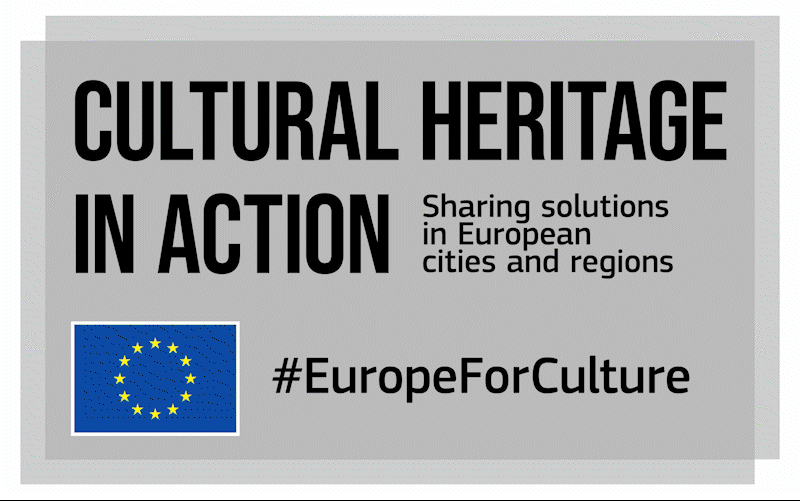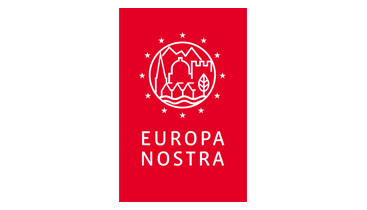Cultural Heritage in Action
About
Cultural Heritage in Action was one of the actions of the European Framework for Action on Cultural Heritage of the European Commission.
Having started in 2020, Cultural Heritage in Action empowered cities and regions to strengthen their cultural heritage policies and initiatives as well as develop innovative solutions to preserve cultural heritage assets.
Across the European Union, cultural heritage is an important asset for culture, economy, tourism and territorial competitiveness. It shapes identities of cities and regions, positively affects well-being and quality of life and contributes to social cohesion. Investing in cultural heritage is strategic for cities and regions. Some have been more successful than others in making bold investments about cultural heritage, and in ensuring long term benefits.
What can be learnt from their experience? How can this be transferred to other local contexts? Let’s find out!
Key figures
years
partners
main topics
good practices
online peer learning visits
ON-SITE PEER LEARNING VISITS
videos
participants to online peer learning visits
applications - online peer learning visits
PARTICIPANTS TO ON-SITE PEER LEARNING VISITS
APPLICATIONS - ON-SITE PEER LEARNING VISITS
Budget (in Euros)
Six interlinked topics
Participatory governance of cultural heritage
Participatory governance of cultural heritage is about participatory and people-centred approaches that involve the public sector, private stakeholders and civil society to:
- Co-design cultural heritage policies and programmes
- Share management and safeguarding of cultural heritage
- Increase the valorisation of cultural heritage in communities
- Use cultural heritage as a resource for community and territorial development
Local administrations can benefit from an increased attachment, better understanding and appreciation of cultural heritage by the involved stakeholders and communities. This might even allow accessing additional recourses for cultural heritage and harnessing the capacities of the involved stakeholders and communities.
Adaptive re-use of heritage buildings
Adaptive re-use of heritage buildings is the act of giving a new use to an obsolete, underused or misused building. In adaptive reuse approach, rather than continuing the building’s existing use through upgrades or restoring it to a specific time period, the new use is defined and adapted to the building while preserving and respecting its value and significance.
Abandoned heritage buildings and sites can present an opportunity for local sustainable development through various benefits:
- Cultural development and space for culture and creativity
- Community development (safeguarded heritage values, spaces for communities, increased sense of belonging).
- Economic development (space for start-ups, encouraging investment, increasing market value, cost and time savings)
- Environment and sustainable development (sustainability, reduced needs of further land consumption etc.)
Quality of interventions on cultural heritage
Interventions on cultural heritage are actions that impact or can impact places or sites of heritage interest and put heritage in danger. Quality interventions are the outcome of multiple factors including aesthetics, habitability, environmental friendliness, accessibility, integration into the surrounding environment and affordability.
Why it is important for cities and regions?
- Quality interventions can enrich lives of citizens and of society in different ways:
- Cultural, through strengthening local identity
- Economic, as they can increase local attractiveness and generate dynamics to attract investors, workers and visitors
- Social and cohesion, as they can generate new social dynamics and contribute to urban regeneration
- Environmental, as quality interventions can reduce materials consumption, involve deep energy retrofit and foster circular economy principles in the built environment.
Recovery and resilience through cultural heritage in a post pandemic world
The focal point of cultural heritage as a vector of sense of place and local identity makes it a central instrument to build resilient cities and regions in a post pandemic world. The cultural heritage sector has an opportunity and an important role to play in building back cities and regions better.
Cultural heritage is a key component in the recovery process due to its potential to engage with contemporary events and co-produce new knowledge and heritage narratives with more diverse communities and perspectives. The cultural heritage capacity to increase citizens engagement would benefit cultural institutions such as museums in a post-Covid world where the trend is to localise the audience. The sanitary crisis is an opportunity to strengthen management strategies based on prevention and disaster response. COVID-19 has proved our creativity to deliver new cultural offers and services that will now become the new normal in our leisure time. Our public heritage spaces are now exposed to new uses accessible to all and available to meet outdoors (from concerts to street performances).
Cultural heritage for local sustainable development
Deeply entangled in its surrounding environment, cultural heritage is subject to changes and adaptations. The effects of climate change are already degrading and irreversibly changing our natural and cultural heritage. It puts thousands of sites with cultural, historic, and archaeological values at risk of being damaged or lost altogether, including archaeological sites that have not yet been discovered.
To safeguard our natural and cultural heritage, decision makers and practitioners in cities need to bring environmental sustainability and action on climate change into their work. Doing so will unlock the potential of cultural heritage to be a driver for a new green and sustainable economy; enhance economic, social, and cultural value in cities and regions; and contribute to all key areas of the European Green Deal.
Governance and financing: new roles for local and regional authorities
Local and regional authorities are increasingly aware of the importance to place citizens as actors rather than users of their territory. Culture and cultural heritage have often been at the forefront of citizens participation and engagement, as artistic intervention is a good trigger to have citizens interested and willing to shape their environment in a co-designed manner. Investing in culture and local cultural heritage can create opportunities to engage and empower citizens through a strong participatory approach.
Besides, culture and cultural heritage have often been used as tools to test and renew local governance models into something more flexible, dialogue-based and co-designed, be it with local stakeholders, associations and organisations, and even inside local and regional authorities themselves.
Participatory governance of cultural heritage
![]()
Participatory governance of cultural heritage is about participatory and people-centred approaches that involve the public sector, private stakeholders and civil society to:
- co-design cultural heritage policies and programmes
- share management and safeguarding of cultural heritage
- increase the valorisation of cultural heritage in communities
- use cultural heritage as a resource for community and territorial development
Why it is important for cities and regions?
Local administrations can benefit from an increased attachment, better understanding and appreciation of the cultural heritage by the involved stakeholders and communities. This might even allow accessing additional recourses for cultural heritage and harnessing the capacities of the involved stakeholders and communities.
The involved stakeholders and communities can benefit by achieving economic, social and cultural opportunities (i.e. increased employment and business opportunities, spaces for leisure) and through a greater sense of ownership.
For more information, please read the report of the Open Method of Coordination working group and the brainstorming report of the Voices of Culture process.
Adaptive re-use of heritage buildings
![]()
Adaptive re-use of heritage buildings is the act of giving a new use to an obsolete, underused or misused building. In adaptive reuse approach, rather than continuing the building’s existing use through upgrades or restoring it to a specific time period, the new use is defined and adapted to the building while preserving and respecting its value and significance.
Why it is important for cities and regions?
Abandoned heritage buildings and sites can be unsafe places and have a negative impact on their neighbourhood. They can present an opportunity for local sustainable development through various benefits:
- cultural development and space for culture and creativity
- community development (safeguarded heritage values, spaces for communities, increased sense of belonging).
- economic development (space for start-ups, encouraging investment, increasing market value, cost and time savings)
- environment and sustainable development (sustainability, reduced needs of further land consumption etc.)
For more information, please read the Leeuwarden declaration on adaptive re-use of built heritage.
Quality of interventions on cultural heritage
![]()
Interventions on cultural heritage are actions that impact or can impact places or sites of heritage interest and put heritage in danger. Quality interventions are the outcome of multiple factors including aesthetics, habitability, environmental friendliness, accessibility, integration into the surrounding environment and affordability.
Why it is important for cities and regions?
- Quality interventions can enrich lives of citizens and of society in different ways:
- Cultural, through strengthening local identity
- Economic, as they can increase local attractiveness and generate dynamics to attract investors, workers and visitors
- Social and cohesion, as they can generate new social dynamics and contribute to urban regeneration
- Environmental, as quality interventions can reduce materials consumption, involve deep energy retrofit and foster circular economy principles in the built environment.
For more information, please read the European quality principles for EU-funded interventions with potential impact upon cultural heritage (2019)
Recovery and resilience through cultural heritage in a post pandemic world
![]()
The focal point of cultural heritage as a vector of sense of place and local identity makes it a central instrument to build resilient cities and regions in a post pandemic world.
The unprecedented sanitary crisis that started in March 2020 has not only affected our lives and our social and cultural fabric but our tangible and intangible cultural heritage. Covid-19 has shut down heritage sites and cultural institutions resulting in huge economic losses. Countless artists, crafts persons and heritage practitioners have seen their means to earn a living disappear and their vulnerability increase. The pandemic has posed, as well, serious social challenges. The quarantine prevented social relationship, isolating communities and broadening social inequalities.
Nonetheless, our cultural intangible heritage has been a part of what has kept us together during the hardest moments of the pandemic. Music and performances on backyards and balconies have connected us to our neighbours and helped us cope by providing an extra psycho-social support while at home. Local public authorities have also done their part in relieving the Covid burden by expanding library services through home delivery; preparing online cultural survival kits and even facilitating a mask fashion week.
Now, in a post pandemic world, the cultural heritage sector has an opportunity and an important role to play in building back cities and regions better.
Cultural heritage is a key component in the recovery process due to its potential to engage with contemporary events and co-produce new knowledge and heritage narratives with more diverse communities and perspectives. The cultural heritage capacity to increase citizens engagement would benefit cultural institutions such as museums in a post-Covid world where the trend is to localise the audience. The sanitary crisis is an opportunity to strengthen management strategies based on prevention and disaster response. COVID-19 has proved our creativity to deliver new cultural offers and services that will now become the new normal in our leisure time. Our public heritage spaces are now exposed to new uses accessible to all and available to meet outdoors (from concerts to street performances).
Key questions
- What have cities/regions learnt from the pandemic crisis when it comes to cultural heritage management/governance etc.? Are they now better equipped to deal with future crisis? How to keep the communities involved in the delivery of new cultural offers and services linked to cultural heritage?
- What has been the impact of the pandemic crisis on the uses of cultural heritage buildings and public spaces? How have they been reinvented for new uses? How to make sure they remain accessible to all and vector of health, wellbeing and quality of life in cities and regions?
- How will cities and regions use the recovery and resilience facility (national plans) in the future? What should be the role of European funding for recovery and building back better?
How are digital tools and opportunities integrated in the development and management of cultural heritage projects and initiatives?
Cultural heritage for local sustainable development
![]()
Deeply entangled in its surrounding environment, cultural heritage is subject to changes and adaptations. Climate change, through consequences such as global warming, rising sea levels, extended dry seasons or floods and heavy storms, adds potential changes to cultural heritage that could be damaging and threatening its very core. The effects of climate change are already degrading and irreversibly changing our natural and cultural heritage. It puts thousands of sites with cultural, historic, and archaeological values at risk of being damaged or lost altogether, including archaeological sites that have not yet been discovered.
It is clear that structural changes are necessary in the management of our cultural environment. In that sense, the climate crisis also offers a moment of radical new thinking and innovation and an opportunity to explore and test innovative ways to protect and adapt monuments, historical buildings and sites from the effects of climate change and natural hazards.
Cities and regions therefore need to adapt cultural heritage, but they can also adapt through it and thanks to it. Cultural heritage can also be a component of climate change resilient solutions themselves and teach us a lot about being part of a more resilient and sustainable world.
Cultural heritage conveys traditional knowledge that builds resilience for change to come and leads us to a more sustainable future. Cultural heritage can become part of a more circular system of adaptive reuse, with heritage buildings being transformed to take future risks and changes in the climate into account. Heritage sites can serve as places of opportunities for climate communication and education, and researchers on historic sites can help us understand past responses to changing climate conditions, which can in turn inform decision makers and practitioners in cities and regions on how to develop adaptation and mitigation strategies for the protection of cultural heritage.
To safeguard our natural and cultural heritage, decision makers and practitioners in cities need to bring environmental sustainability and action on climate change into their work. Doing so will unlock the potential of cultural heritage to be a driver for a new green and sustainable economy; enhance economic, social, and cultural value in cities and regions; and contribute to all key areas of the European Green Deal.
Key questions
- How to ensure a sustainable urban and regional regeneration through cultural heritage? How to develop a more sustainable cultural tourism in cities and regions?
- How can cities and regions invest in cultural heritage to ensure a successful European Green Deal? How are cities and regions contributing through cultural heritage investments to the New European Bauhaus? How is cultural heritage contributing to reaching the Sustainable Development Goals at local level?
How are cities and regions making the most of cultural heritage to face future changes in the climate and adapt their local territories to these new threats? How are cities and regions protecting cultural heritage from risks linked to climate change?
Governance and financing: new roles for local and regional authorities
![]()
Cultural heritage and cultural environments, whatever their size, are an essential resource to build identity, sense of belonging and can serve for social cohesion, pride and integration. Inhabitants want to feel at home in their city/region and be part of a distinctive community with an identity; they are keener to engage in the protection and enhancement of what they consider their heritage.
Local and regional authorities are increasingly aware of the importance to place citizens as actors rather than users of their territory. Over the years, this has translated into initiatives involving citizens in the development and management of public policies or approaches seeking to engage in a dialogue with stakeholders who are part of the distinctive identity of a territory. Citizens have been encouraged to take on a wider range of responsibilities to ensure that local services continue to be delivered and improved effectively in the future.
Culture and cultural heritage have often been at the forefront of citizens participation and engagement, as artistic intervention is a good trigger to have citizens interested and willing to shape their environment in a co-designed manner. Investing in culture and local cultural heritage can create opportunities to engage and empower citizens through a strong participatory approach.
Besides, culture and cultural heritage have often been used as tools to test and renew local governance models into something more flexible, dialogue-based and co-designed, be it with local stakeholders, associations and organisations, and even inside local and regional authorities themselves.
Key questions
- What are the new roles of local and regional authorities when it comes to supporting cultural heritage organisations and stakeholders?
- How are cities and regions organising participatory governance, community involvement and co-design of policies linked to cultural heritage? How are they addressing the needs and expectations of people at different ages, from different genders, from different communities’ background? How are they dealing with contested and dissonant heritage?
- How are digital tools and opportunities integrated in the development and management of cultural heritage projects and initiatives?
Consortium partners
Eurocities in partnership with KEA, ERRIN, Europa Nostra and the Architects Council of Europe, have been selected by the European Commission to implement Cultural heritage in action. The project is funded by the European Union’s Creative Europe programme until January 2023. The project is part of the European Framework for Action on Cultural Heritage of the European Commission, adopted in December 2018 as a legacy document of the European Year of Cultural Heritage 2018.






